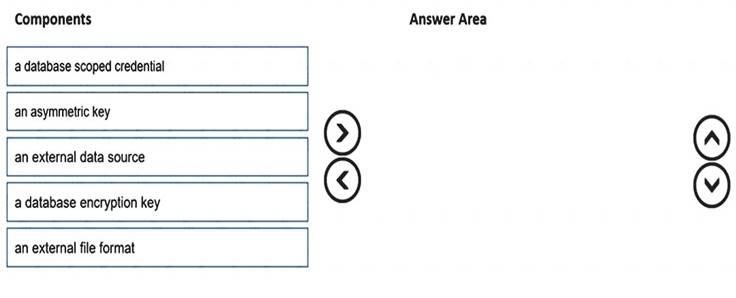- (Exam Topic 3)
Note: This question is part of a series of questions that present the same scenario. Each question in the series contains a unique solution that might meet the stated goals. Some question sets might have more
than one correct solution, while others might not have a correct solution.
After you answer a question in this section, you will NOT be able to return to it. As a result, these questions will not appear in the review screen.
You have an Azure Storage account that contains 100 GB of files. The files contain rows of text and numerical values. 75% of the rows contain description data that has an average length of 1.1 MB.
You plan to copy the data from the storage account to an enterprise data warehouse in Azure Synapse Analytics.
You need to prepare the files to ensure that the data copies quickly. Solution: You copy the files to a table that has a columnstore index. Does this meet the goal?
Correct Answer:
B
Instead convert the files to compressed delimited text files. Reference:
https://docs.microsoft.com/en-us/azure/sql-data-warehouse/guidance-for-loading-data
- (Exam Topic 3)
You have an Azure subscription that contains an Azure Blob Storage account named storage1 and an Azure Synapse Analytics dedicated SQL pool named Pool1.
You need to store data in storage1. The data will be read by Pool1. The solution must meet the following requirements: Enable Pool1 to skip columns and rows that are unnecessary in a query.
Enable Pool1 to skip columns and rows that are unnecessary in a query.  Automatically create column statistics.
Automatically create column statistics. Minimize the size of files. Which type of file should you use?
Minimize the size of files. Which type of file should you use?
Correct Answer:
B
Automatic creation of statistics is turned on for Parquet files. For CSV files, you need to create statistics manually until automatic creation of CSV files statistics is supported.
Reference:
https://docs.microsoft.com/en-us/azure/synapse-analytics/sql/develop-tables-statistics
- (Exam Topic 3)
You have an Azure Synapse Analytics dedicated SQL pool mat contains a table named dbo.Users.
You need to prevent a group of users from reading user email addresses from dbo.Users. What should you use?
Correct Answer:
B
- (Exam Topic 3)
You are responsible for providing access to an Azure Data Lake Storage Gen2 account.
Your user account has contributor access to the storage account, and you have the application ID and access key.
You plan to use PolyBase to load data into an enterprise data warehouse in Azure Synapse Analytics. You need to configure PolyBase to connect the data warehouse to storage account.
Which three components should you create in sequence? To answer, move the appropriate components from the list of components to the answer area and arrange them in the correct order.
Solution:
Does this meet the goal?
Correct Answer:
A
- (Exam Topic 3)
Note: This question is part of a series of questions that present the same scenario. Each question in the series contains a unique solution that might meet the stated goals. Some question sets might have more than one correct solution, while others might not have a correct solution.
After you answer a question in this section, you will NOT be able to return to it. As a result, these questions will not appear in the review screen.
You plan to create an Azure Databricks workspace that has a tiered structure. The workspace will contain the following three workloads: A workload for data engineers who will use Python and SQL.
A workload for data engineers who will use Python and SQL. A workload for jobs that will run notebooks that use Python, Scala, and SOL.
A workload for jobs that will run notebooks that use Python, Scala, and SOL. A workload that data scientists will use to perform ad hoc analysis in Scala and R.
A workload that data scientists will use to perform ad hoc analysis in Scala and R.
The enterprise architecture team at your company identifies the following standards for Databricks environments: The data engineers must share a cluster.
The data engineers must share a cluster. The job cluster will be managed by using a request process whereby data scientists and data engineers provide packaged notebooks for deployment to the cluster.
The job cluster will be managed by using a request process whereby data scientists and data engineers provide packaged notebooks for deployment to the cluster. All the data scientists must be assigned their own cluster that terminates automatically after 120 minutes of inactivity. Currently, there are three data scientists.
All the data scientists must be assigned their own cluster that terminates automatically after 120 minutes of inactivity. Currently, there are three data scientists.
You need to create the Databricks clusters for the workloads.
Solution: You create a Standard cluster for each data scientist, a Standard cluster for the data engineers, and a High Concurrency cluster for the jobs.
Does this meet the goal?
Correct Answer:
B
We need a High Concurrency cluster for the data engineers and the jobs.
Note: Standard clusters are recommended for a single user. Standard can run workloads developed in any language: Python, R, Scala, and SQL.
A high concurrency cluster is a managed cloud resource. The key benefits of high concurrency clusters are that they provide Apache Spark-native fine-grained sharing for maximum resource utilization and minimum query latencies.
Reference: https://docs.azuredatabricks.net/clusters/configure.html